Not So Gently Down The Stream

Matt Naud, environmental coordinator for the city of Ann Arbor, gives the universal gestural sign for Whoah-there-fella, as Steven Yaffee of the UM School of Natural Resources & Environment looks on.
At the first of three public meetings on the future of the Huron River held Wednesday evening at Forsythe Middle School, the Huron River and Impoundment Management Plan (HRIMP) committee’s vision for the Huron River’s future was presented. It reads in part: “The river and its publicly-owned shoreline and riparian areas create a blue and green corridor across the city that contains restored natural areas and adequate, well-sited public trails and access.”
It was that sentence that prompted the first whispered interactions between The Chronicle and other folks at our table: What, exactly, does “riparian” mean? Russ Miller, a rower who’s now hooked on the sport after taking it up only a couple of years ago, had a notion that it had to do with the place where the water meets the shore, but it was his PALM handheld computing device that provided a definitive answer: interface area between land and a stream.
The Forsythe meeting itself could fairly be described as an interface between two groups as different as land and water: people keen to see Argo Dam preserved, and those who wouldn’t mind seeing it disappear.
Why Are We Talking about Argo Dam Now?
Based on the public participation at Wednesday’s meeting, many people on both sides of the Argo Dam question perceive the idea of dam removal to have developed as an isolated question about that dam. But Steven Yaffee of the University of Michigan’s School of Natural Resources & Environment introduced the informational part of the presentation to around 150 people by giving some background on HRIMP in the general context of planning for the length of the Huron River. In March 2006, it was the Ann Arbor environmental commission that created the HRIMP committee and charged them with developing a Huron River and Impoundment Management Plan. [A list of committee members is included in the primer for planning along the Huron, which is a PDF file with native digital text (i.e., not scanned).]
HRIMP’s current timeline for work after the last of the public meetings is to spend February hammering out a draft plan, in March present the draft plan to the city’s park advisory commission and environmental commission with public hearings at both bodies, and finally sometime in April recommend a plan to city council, again with a public hearing. April won’t be the first time some of the councilmembers will be seeing the material: Stephen Rapundalo and Margie Teall attended Wednesday’s meeting.
The remaining public meetings before the committee works on the draft will be held Jan. 31 (9 a.m. – noon); and Feb. 5 (7-10 p.m.) at Forsythe Middle School, 1655 Newport Road [check dates]
So where did the impetus to form a committee and develop a river plan come from? Yaffee pointed out that the Huron River is the most prominent natural feature in the city of Ann Arbor, and the city owns most of the shoreline, yet there is no plan for its management. Further, there is no budget for its management. The current initiative is partly a response to this gap.
It’s also the condition of the river itself and the four ponds formed by the four dams (Barton, Superior, Argo, Geddes) that has started to force the question of river management. The city of Ann Arbor’s environmental coordinator, Matt Naud, presented the challenges now faced by the city. The build-up of sediment over decades behind the dams and the interference of aquatic vegetation with uses like canoeing and rowing means that investment needs to be made in dredging and vegetation harvesting, if those uses are to continue.
Further, Michigan’s Department of Environmental Quality set a deadline for Dec. 31, 2008 for the city of Ann Arbor to address maintenance issues with the toe drains under the earthen berm that extends along the mill race on the east side of Argo Dam. With that deadline passed, DEQ has given the city an extension until June 2009 to present a plan for the toe drains. If the plan is to remove Argo Dam, then the toe drain maintenance issue could become moot.
Three Scenarios for Argo Dam
There were three different scenarios presented for the future of Argo Dam: (i) preservation of the dam as it is, (ii) complete removal of the dam, and (iii) partial removal of the dam with construction of whitewater drops.
It’s only under the scenario of complete dam removal that the issue of aquatic vegetation management disappears – but that’s only for Argo Dam. The issue of management of the vegetation in Barton Pond would become even more crucial in that scenario, because Barton is envisioned as one of the alternative venues for rowers.
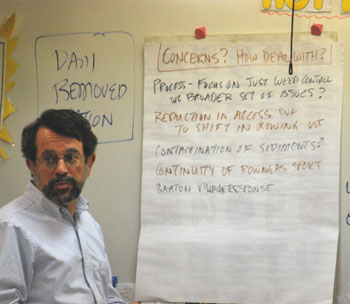
Steven Yaffee, of UM's School of Natural Resources & Environment, listed out people's concerns as they voiced them.
Why isn’t the removal of Barton Dam being contemplated? One reason is that Barton Pond is the source of 80% of the drinking water for the city of Ann Arbor, and another is that the hydro-power generated at Barton Dam generates a small profit. Superior Dam is the other dam currently generating hydro-power. According to Naud, it pays for itself with the power it produces. One alternative not included among the three scenarios presented is to restore hydroelectric generation to Argo Dam. The 2008 hydroelectric feasability study suggests something like a 44-year payback on the required investment.
The removal of Geddes Dam, the other purely recreational dam (i.e., non-hydroelectric generating dam) besides Argo, was also not presented as an alternative. As a part of his presentation, Naud described how Geddes Dam had failed during the flood of 1968, and when it was rebuilt in 1974, it was guided by the vision of Guy Larcom (the former city administrator for whom the city hall building is named) for the recreational facility that is now Gallup Park. But hydroelectric capacity was not included in the rebuilding plans.
Breakout Session: Complete Removal of Argo Dam
The status of Geddes Dam arose in one of the break-out sessions that followed the large-group presentation and the answering of clarificational questions. One participant said that when he reflected on the reasons given for the removal of Argo Dam, those same reasons were arguments for removal of Geddes Dam.
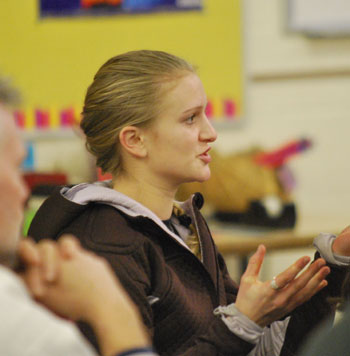
The question this rower had for proponents of dam removal: "Why is it so important to remove the dam?"
The breakout sessions were based on the different scenarios for Argo Dam. And the comment about Geddes Dam came in Room 310, where the topic was complete dam removal at Argo.
Yaffee was acting as the facilitator in the room, along with Laura Rubin of the Huron River Watershed Council. The room was filled mostly with folks from the rowing community but included hikers and fishermen, too.
The dialogue threatened to bog down in the discussion of dollars: What alternative is the cheapest? In his presentation to the large group, Naud had attached some dollar amounts to various parts of different scenarios – which seemed intended to illustrate the point that under any plan moving forward, large amounts of money would need to be invested. Those amounts, however, led to the marshalling of arguments for and against scenarios based on cost. After much back-and-forth on that question, one person in Room 310 offered: “We don’t know anything – we should take the numbers out of it.” But that met with the response from another person: “We’re here to talk about numbers!”
People did manage to steer clear of the numbers hazard enough of the time that the non-financial aspects of the issue rose to the surface. Rowers were keen to make the case that Argo Pond was not just great for rowing, it was really the only place for that activity. When a Bird Hills hiker asked the rowers: “When will it get to a point when you’re not blasting people with megaphones?” the response from one young rower was to emphasize that while there were lots of places to enjoy walking, there was only one place to row. The implied message: Find someplace else to walk, if you don’t like the noise.
Talking to University of Michigan rowing coach Gregg Hartsuff after the breakout session, he told The Chronicle that the megaphone noise comes from the motorized launches that accompany a rowing boat during a training session. Coaches convey instructions to their team during pracice with the megaphones. Wireless technology that would allow a rowing coach to speak into a microphone that would send a signal to speakers built into the bottom of the boat costs around $1,000 per boat, Hartsuff said. Asked if the yelling into the microphone itself could still pose a noise problem, Hartsuff said that he didn’t generally yell at his team – because his goal was to get his guys to relax and that yelling had the potential to cause them to tense up in a way that undermined smooth stroking.
Interesting fact from the coach: UM rowers pay $2,300 a year in order to participate in the sport.
It’s not just the UM boats that would need to be outfitted with speaker technology in order to eliminate megaphone noise. Some 540-570 rowers use Argo pond on a regular basis. And it’s not just high school and collegiate rowers. Marcia Leonard, who had sat at The Chronicle’s table and rows with the Ann Arbor Rowing Club, doesn’t fit either category. That statistic about the number of rowers was one source of friction, because canoe usage was measured in terms of paddling trips (50,000 a year) whereas rowing usage was reported by the number of participants.
Anglers were also represented in the room in the form of Paul Christensen, president of the Huron River Fly Fishing Club. He said that removing Argo Dam would give fly fishermen an extra mile or so of wade-able water.
Some of the discussion focused on the question of whether trout could be introduced into the Huron, and if they could, whether they counted as “natural.” Also a part of the discussion of what counts as “natural” was the river itself. Rubin reduced the issue to what a river’s natural function is: to transport water and sediment. A dam stops water and sediment, Rubin said, and therefore interferes with a river’s natural function.




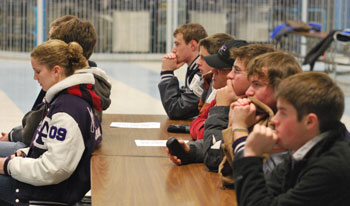
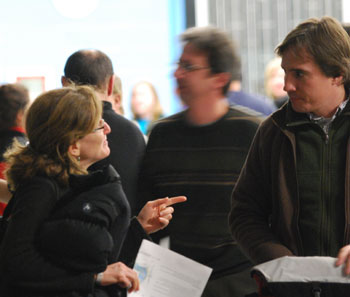
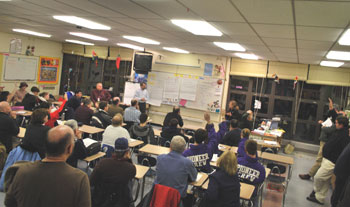

Nice article. It would be helpful to add information about the hybrid version – mill raceway has portage removed and provides passage for canoes, kayaks and river critters and Argo Dam is replaced with whitewater park. This option keep Argo Pond available for the rowers.
I’d also like to see more info about the whitewater park and how the potential designs address the problem of Allen Drain. No one will want to paddle in the filth that comes out of that pipe when water is high, which is when you run whitewater. So the whitewater will either have to be moved upstream or Allen Drain will have to be diverted further downstream.
Facilitation of these meetings is key. Members of the rowing community stand to lose their long-time, self-described “playing field,” but Ann Arbor residents and visitors will gain 27 acres of new park land, improved in-stream and riparian habitat, better fishing opportunities, and the potential for fresh commercial growth along an otherwise cold, industrial stretch of river. But the only voices heard at Wednesday’s meeting were those of rowing supporters. When others following the agenda issued comments, they were routinely shot-down by members of the rowing community. This tit-for-tat won’t result in any form of progress or innovation if the facilitators don’t keep folks focused on the agenda. To the rowers: let the voices of fishermen, paddlers, birdwatchers, walkers, hikers, bicyclists, and nature enthusiasts be heard. The only certainty offered at Wednesday’s meeting was that you will continue to have a place to row, on Argo or elsewhere, and that any transition that is made will be seamless. Consider the river environment, the value of waterfront parklands to your city, and your fellow watermen and women. A solution that benefits the river and the community will inevitably benefit rowers.
You can look to other dam removal projects to see the benefits of returning water to it’s natural path. Having been a rower in college I can understand the desire to maintain a local place to row, however Gallup or Barton would actually be better areas as the bends in the river above Argo are not desirable.
This is why I read and contribute to the Chronicle. And why I cancelled my subscription to the News
Kris–Gallup would actually not be suitable for rowing, mostly due to the massive amounts of seaweed found there. If you have rowed, you must know that oars and skegs get easily tangled on that, resulting in equipment damage and unsafe conditions for canoes, kayaks, etc if a coxswain loses their steering due to seaweed on the rudder. Also, people keep saying rowing could be moved to Barton, but I don’t see how they are going to find water front space there to put in a dock and store all of the boats that are currently kept at Argo.
I’m curious about the statement in comment 3 “the potential for fresh commercial growth along an otherwise cold, industrial stretch of river”
I thought the only “new land” that would be created was park land. Would removing the dam result in increased land that is not park land?
The city populace has adapted to the recreation opportunities afforded by the current configuration of the four dams.
New – and potentially uncertain – opportunities can emerge in a reconfigured group of dam structures but this new configuration has fewer proponents than those enjoying the existing facilities.
Action as recommended – whatever that might be – all has a cost component which will be a problem. The infrastructure will require monies that will eat into less physical plant operations elsewhere in the budget. Some group will get less because of action on the dams.
That group will be the problem. It would be easy for a politician to cast the impression of money for the dams as a competitor to some sacred cow funding … and the choice presented as one or the other… I can hear the mooing now.